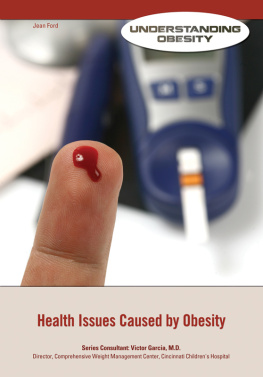PRAISE FOR XL LOVE
An insightful and compassionate discussion of the many ways intimate human relationships are being challenged by the obesity epidemic.
D AVID A. K ESSLER , MD, AUTHOR OF The End of Overeating
In this raw, honest, page-turning account, we catch a rare glimpse into the hidden story of how obesity not only affects our economy, our health care system, or even the academic achievement of our kids, but how it threatens the very nature of love itself.
M ARK H YMAN , MD, #1 New York Times BESTSELLING AUTHOR OF The Blood Sugar Solution AND The Blood Sugar Solution 10-Day Detox Diet
In her groundbreaking book, Sarah offers a compelling, provocative, and very insightful look into one of the biggest issues America faces today. This is a must-read!
J AY M CGRAW , CREATOR AND EXECUTIVE PRODUCER OF The Doctors
XL Love has the numbers and research to back up the human stories Sarah Varney brings to life with such vivid writing and a painters eye for detail. This book often rises far above its subject matter to say a lot about who we are and how we view ourselves.
S TEVE D RUMMOND , SENIOR NATIONAL EDITOR , NPR NEWS
Sarah Varney has expertly translated the science of the impact of obesity into relatable stories of real people. She explores in a compassionate way how obesity has become a barrier from intimate relationships for millions of people.
M ADELYN F ERNSTROM , P HD , DIET AND NUTRITION EDITOR , Today
Its about time we understood and honored the extraordinary challenges faced by men and women seeking intimacy but carrying excess physical weight. XL Love gifts the reader with a unique glimpse into an untouched frontierthe intimate details of how sexuality is affected by weight.
P AMELA M. P EEKE , MD, MPH, FACP, New York Times BESTSELLING AUTHOR OF The Hunger Fix
For Fountain, Jake, and Jesse
And for Nana, whose generous spirit warms us still
Overweight bodies will soon be the modal human form.
Alexandra Brewis, Obesity and Human Biology:
Toward a Global Perspective, American Journal of Human Biology,
24, no. 3 (May/June 2012): 25860.
Sex is not fundamentally democratic or kind.
Alain de Botton
CONTENTS
P ROLOGUE
Jackson, Mississippi
The helium balloons turn slowly in the still, warm air. One balloon is a crouching green frog; another, a smiling monkey printed with Hang In There; another, a 3-foot-tall pink foot announcing, Its a girl!
The balloons are tied with string to rows of incubators, and in those incubators are rows of newborns the size of kittens. The vast hallnearly a football field longbeeps and pulses in the muted southern spring light. And yet, amid the machines, there are no sounds of babies crying. In their incubators, where the humidity reaches 97 percent to replenish the water they lose through their translucent skin, the babies wince and constrict, but no sound emerges from their mouths. Born months early, their lungs are so underdeveloped or their bodies so riddled with tubes that they cannot cry aloud.
Tied to one of the beds is a Minnie Mouse balloon with a bright pink bow and earnest, expectant brown eyes. Inside the isolette is a wisp of bone and skin and hairthe human form as it looks inside a mothers womb. Next to this baby girl is a boy whose legs and arms are no thicker than a crayon; a blue tube snakes into his nose and delivers oxygen, while a second colorless tube clears out carbon dioxide. Another tubethis one orangedelivers breast milk directly to his miniature stomach. He weighs just over a pound and a half.
Curiously, in between some of the tiny babies are exceptionally large onesbabies who weigh 12 pounds or more at birth and yet lie here with breathing tubes. A nurse in lilac scrubs asks another nurse, Is he IDM? The nurse nods back. Infant of diabetic mother. The newborns rapid breathing signals immature lungs. He came into being amid a flood of glucose; his own pancreas tried to compensate by producing even more insulin, thus fueling such rapid growth in the womb that certain organs couldnt keep pace.
The neonatal intensive care unit at the University of Mississippi Medical Center in Jackson is one of the largest in the nation; its a puzzling distinction given the Magnolia States small population. Yet Mississippians, who in just a generation have become the nations heaviest Americans, live in a future that the rest of the United States is just now catching up to. These rows of underdeveloped and overgrown babiesmany born to extremely heavy mothers whose chronic hypertension and diabetes forced them into premature birthare signs of the ultimate collision of fat and sex, a collision that can have profound consequences for the physical health of these babies and confound their journey into sexual beings as they grow up.
CHAPTER ONE
Beginnings: Puberty, Puppy Love, and the Prom
North of Jackson, the Mississippi Delta opens into a flat stretch of saturated, fertile earth between the Yazoo and Mississippi Rivers. In the winter and early spring, the fields along the country roads here are covered with snarled, dormant kudzu vines. The eerie gray vines are everywhere, and the totality of the takeover is startling: They hang in a brittle mop from trees; they turn hillsides into resting Snuffleupaguses with unruly coats of gray fur; they threaten to overtake dirt driveways. Kudzu has become the curse of the Delta: Farmers have tried to burn it, only to witness the irrepressible vines roaring back to life with lush leaves in summer. Entrepreneurs have tried to turn it into an earth-friendly biofuel, with little success. Livestock producers have set ravenous goats afield, only to find their four-chambered stomachs no match for the invasive plants virility.
Like the impressively resistant kudzu, the disease of obesity, too, has crept into the Delta and the nation beyond. A rarity just a few decades ago, it is overtaking everything in its wayspreading through homes and schools, across cotton fields and catfish farms; altering the genes that parents pass down to their children; and disrupting how and when the very stages of life are marked, including the awkward progression from childhood to the sexual self.
The Delta town of Belzoni70 miles from Jacksonowes its existence to the slithering path of the Yazoo River and the tenacious and ugly catfish that bathe in its waters. The river forms the southern border of the town and provides the water for the areas fabled catfish farmers. Some 40,000 acres are underwater, sunken to provide vast pools for farm-raised bottom-dwellers. The small town has dwindled in size in the last decade, but Belzoni persists in its claim as Catfish Capital of the World. On the towns main thoroughfare, 5-foot-tall painted catfish sculptures stand on their tails: a Superman with a curious brown fedora; a farmer in blue overalls; a whiskered dandy in a green bow tie.
Propped up on the tidy brick sidewalk next to one of the sculptures is a handwritten chalkboard announcing the days lunchtime special at the Greasy Row Grill: fried pork chops. Inside the diners kitchen, a vat of grease crackles with a new order of fries. Just about anything goes into the fryer to be encased in a crispy, high-calorie coat of oil: green beans, mushrooms, cheese sticks, tamales, pickles, crawfish tails, and, of course, catfish.









